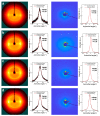The Influence of Cellulose Nanocrystal Characteristics on Regenerative Silk Composite Fiber Properties
- PMID: 36984203
- PMCID: PMC10052345
- DOI: 10.3390/ma16062323
The Influence of Cellulose Nanocrystal Characteristics on Regenerative Silk Composite Fiber Properties
Abstract
Cellulose nanocrystals (CNCs), obtained from natural resources, possess great potential as a bioderived reinforcement for natural-fiber-reinforced composites (NFRPs) due to their superior crystallinity and high aspect ratio. To elucidate the specific parameters of CNCs that significantly affect their mechanical performance, various CNCs were investigated to fabricate high-performance nanocomposite fibers together with regenerated silk fibroin (RSF). We confirmed that the high aspect ratio (~9) of the CNCs was the critical factor to increase the tensile strength and stiffness rather than the crystallinity. At a 1 vol% of CNCs, the strength and stiffness reached ~300 MPa and 10.5 GPa, respectively, which was attributed not only to a stable dispersion but also to alignment. This approach has the potential to evaluate the parameters of natural reinforcement and may also be useful in constructing high-performance NFRPs.
Keywords: aspect ratio; cellulose nanocrystals; composite fibers; crystallinity; regenerated silk.
Conflict of interest statement
The authors declare no conflict of interest.
Figures







References
-
- Vanderfleet O.M., Cranston E.D. Production Routes to Tailor the Performance of Cellulose Nanocrystals. Nat. Rev. Mater. 2021;6:124–144. doi: 10.1038/s41578-020-00239-y. - DOI
Grants and funding
LinkOut - more resources
Full Text Sources

